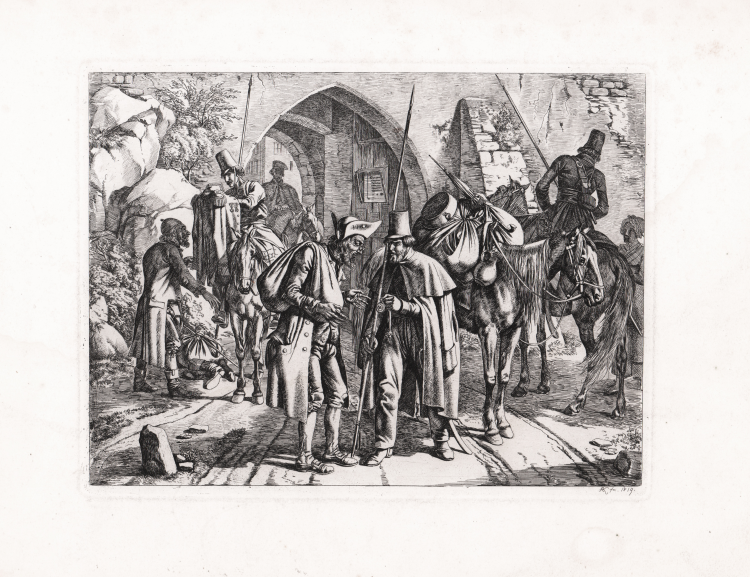



| Reference: | S42294 |
| Author | Johann Adam KLEIN |
| Year: | 1819 |
| Measures: | 222 x 170 mm |


| Reference: | S42294 |
| Author | Johann Adam KLEIN |
| Year: | 1819 |
| Measures: | 222 x 170 mm |
Etching and engraving 1819, signed and dated in plate at lower right.
Magnificent proof, printed on contemporary wove paper, with margins, in perfect condition.
Johann Adam Klein was a German painter and engraver with a special talent for drawing animals. Inspired by the Napoleonic wars, he drew and engraved the soldiers of the warring parties, in their uniforms and with their baggage, horses and wagons, in great detail.
Johann Adam KLEIN (Norimberga 1792 - Monaco 1875)
|
Johann Adam Klein (24 November 1792, Nuremberg – 21 May 1875, Munich) was a German painter and engraver.
At the age of eight, he received his first drawing lessons from the landscape etcher, Georg Christoph von Bemmel (1765-1811). From 1802, he attended the Nuremberg drawing school, under Gustav Philipp Zwinger. Three years later, he became an apprentice in the studios of the copper engraver, Ambrosius Gabler [de], who taught him etching. Gabler noticed that he had a special talent for drawing animals, so he sent him to the cattle market to sketch. With support from the art dealer, Johann Friedrich Frauenholz [de], he went to Vienna in 1811, where he enrolled at the Academy of Fine Arts. Inspired by the Napoleonic Wars, he drew and etched the soldiers of the warring parties, in their uniforms and with their baggage, their horses and wagons, in great detail.
Back in Nuremberg in 1815, he made a survey of the Rhine with Count Erwein von Schönborn, a noted art collector. He was back in Vienna the following year, with his friend, the etcher Johann Christoph Erhard [de], where Prince Klemens Wenzel Lothar von Metternich became a patron and sent him to Hungary to study and sketch horses. He continued to travel, seeking inspiration for his works, visiting Styria and making his way to Italy, with the help of a grant from Prince Louis of Bavaria, where he was in contact with the German artists' colony in Rome.
He finally settled down in 1823, when he married Karoline Wüst, and remained in Nuremberg until her death in 1837. Shortly after, he moved to Munich where, in 1839, he married the widow of an engraver named Wolf. He remained there until his death in 1875.
|
Johann Adam KLEIN (Norimberga 1792 - Monaco 1875)
|
Johann Adam Klein (24 November 1792, Nuremberg – 21 May 1875, Munich) was a German painter and engraver.
At the age of eight, he received his first drawing lessons from the landscape etcher, Georg Christoph von Bemmel (1765-1811). From 1802, he attended the Nuremberg drawing school, under Gustav Philipp Zwinger. Three years later, he became an apprentice in the studios of the copper engraver, Ambrosius Gabler [de], who taught him etching. Gabler noticed that he had a special talent for drawing animals, so he sent him to the cattle market to sketch. With support from the art dealer, Johann Friedrich Frauenholz [de], he went to Vienna in 1811, where he enrolled at the Academy of Fine Arts. Inspired by the Napoleonic Wars, he drew and etched the soldiers of the warring parties, in their uniforms and with their baggage, their horses and wagons, in great detail.
Back in Nuremberg in 1815, he made a survey of the Rhine with Count Erwein von Schönborn, a noted art collector. He was back in Vienna the following year, with his friend, the etcher Johann Christoph Erhard [de], where Prince Klemens Wenzel Lothar von Metternich became a patron and sent him to Hungary to study and sketch horses. He continued to travel, seeking inspiration for his works, visiting Styria and making his way to Italy, with the help of a grant from Prince Louis of Bavaria, where he was in contact with the German artists' colony in Rome.
He finally settled down in 1823, when he married Karoline Wüst, and remained in Nuremberg until her death in 1837. Shortly after, he moved to Munich where, in 1839, he married the widow of an engraver named Wolf. He remained there until his death in 1875.
|